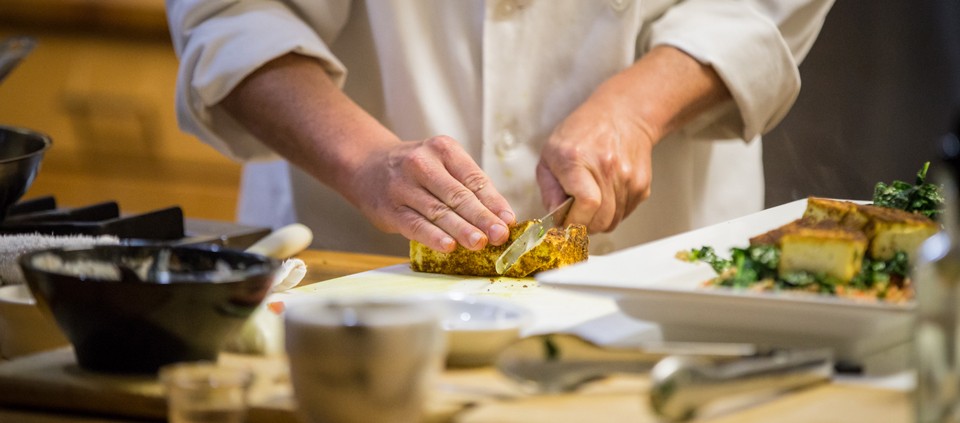The Yoga of Cooking

When it comes to food, everybody’s an expert. We all eat, and we all have our own ideas of what good food is and how to cook it. I like to think of eating and cooking as not so different from a yoga practice—there are guidelines, but we each choose the style that fits us best and results in the maximum health and enjoyment for mind and body.
With that in mind, here are my tips for fine-tuning your cooking practice.
Prepare your props. Once you’re on the mat, you want to stay focused, right? You don’t want to run across the room in the middle of class to grab your blocks and a strap. It’s the same in the kitchen. Chefs call it mise en place—“everything in its place.” Lay out all the ingredients for the dish you’re making—which is also a good way to be sure that you have what you need and someone didn’t make a smoothie with that can of coconut milk you were saving for a Thai curry. Set up all your equipment within easy reach, so you don’t have to dig around for it in the bottom of a drawer or in the dirty dish pile while your garlic is burning.
Sequence your flow. In general, a yoga practice begins with warm-ups, moves on to standing postures, and finishes up with a twist and a Savasana. Cooking can also be a vinyasa in its own way. If you’re cooking a grain, such as rice or quinoa, get that going first, because it can sit for a few extra minutes without any problem. Next, prepare the slower-cooking vegetables, which you can adjust by chopping them in bigger or smaller pieces—the smaller you cut it, the faster it will cook, whether you’re baking root vegetables or sautéing onions. With stir fries or other one-pot dishes, add dry spices early in the process, with oil, to allow them to bloom and maximize their flavor. Fresh herbs and leafy vegetables should be added last. Proper sequencing will also make cleanup easier, because you’ll have more time in between steps to wash a dish or put away extra ingredients. If you can make a meal in 20 minutes, but it takes you three hours to clean up, that doesn’t count as time-saving—unless, of course, mindful dishwashing is a practice for you.
Listen to your own body. Just as you adjust your yoga practice depending on how you’re feeling that day, or that hour, you can adjust the way you eat. Be in the moment and go with where you’re at. One morning, I’ll have kale and miso soup for breakfast and, the next day, I’m all over the French toast. I’ve learned from watching my kids: My daughter has been eating salad for as long as she’s had teeth, but every once in a while, she’ll chow down on some serious protein. My son is always moving—he burns calories like crazy so he eats lots of carbs, but then he’ll eat a ton of carrots. Their diets naturally balance out over time; every single meal doesn’t have to be balanced.
Make modifications. No matter how long you’ve been doing yoga, or cooking, you can always learn new tricks. I had been cooking professionally for 18 years when I discovered that you don’t have to peel ginger—you can just use a cheese grater to mince it. Here are a few “assists” to make your cooking practice even more relaxing:
- Collect compost in a “garbage bowl” that you keep on the counter while you work.
- Freeze or refrigerate onions for 30 minutes before chopping to prevent tears; cold slows down the production of sulfenic acid, which is what makes you cry.
- To make sure your spices stay potent, buy them in small amounts rather than large containers. Mark them with the date you bought them and replace ground spices every six months and whole spices every 10 months.
- Store produce by wrapping it lightly rather than tightly; vegetables continue to release ethylene even after they’re picked, which will speed up spoilage if it’s trapped in plastic.
- To make your kale salad extra tender, slice the leaves thinly (removing the stems), toss with vinaigrette, and let it sit overnight in the fridge so the vinegar has time to break down the fibers.
- Cook garlic and ginger until you smell it, then take it off the heat immediately or add liquid to stop the cooking process.
Namaste and bon appetit!
© Kripalu Center for Yoga & Health. All rights reserved. To request permission to reprint, please e-mail editor@kripalu.org.
Jeremy Rock Smith, Kripalu faculty and a graduate of the Culinary Institute of America, began his career in classical French cuisine.
Full Bio and Programs